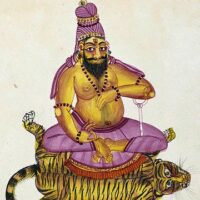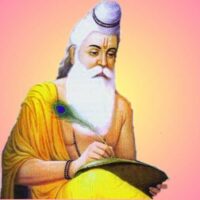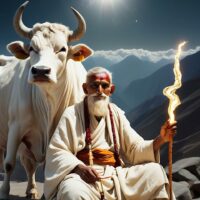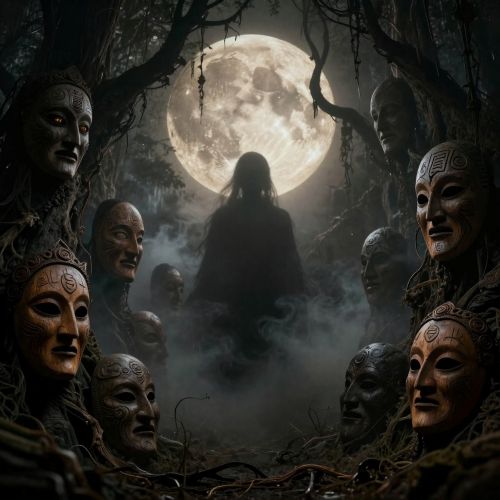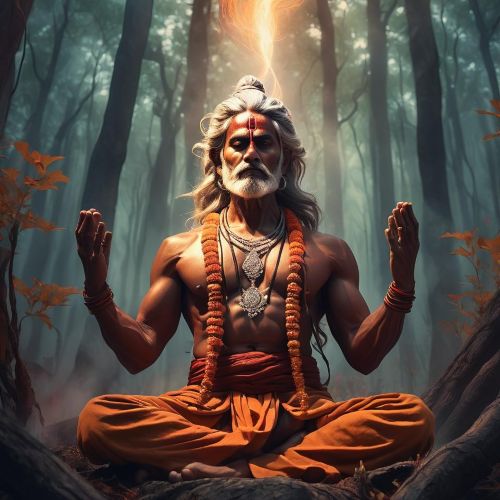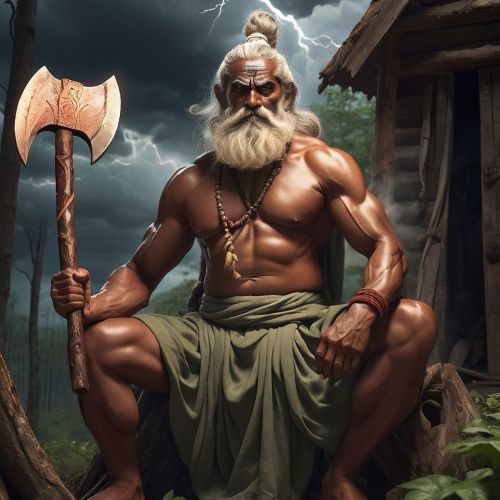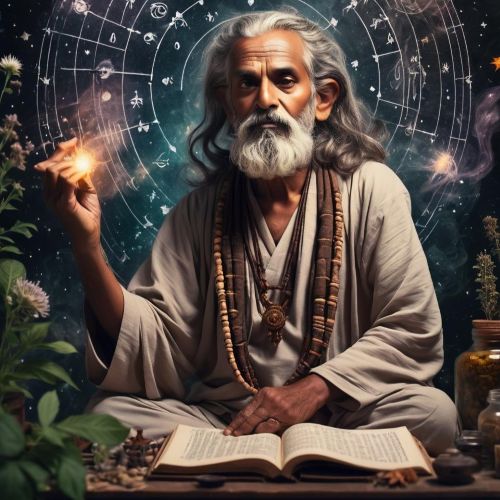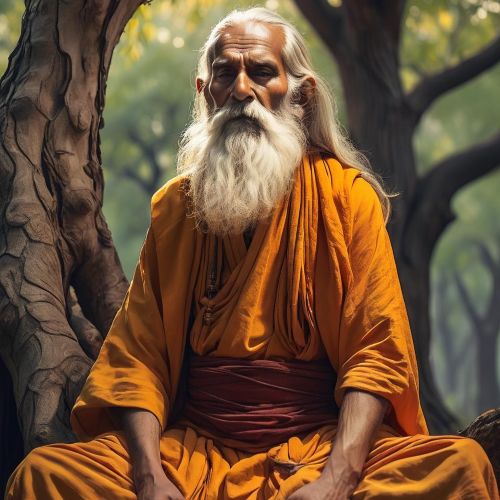Vasistha : Sage of Cosmic Wisdom
Listen
At a glance
| Description | |
|---|---|
| Origin | Indian Mythology |
| Classification | Mortals |
| Family Members | Brahma (Father), Arundhati (Wife), Shakti, Citraketu, Dyumat (Sons) |
| Region | India |
| Associated With | Wisdom, Cosmic Knowledge |
Vasistha
Introduction
Vasistha is one of the most illustrious sages of the Vedic age, celebrated in Hindu mythology as a Brahmarishi and one of the Saptarishis—the seven great seers entrusted with preserving divine wisdom. His presence is deeply woven into the Rigveda, where he is credited with authoring numerous hymns that express profound spiritual truths. Beyond his contributions to scripture, Vasistha is remembered as the royal priest and counselor of the Ikshvaku dynasty, guiding kings such as Lord Rama with his moral and spiritual authority. His wisdom is immortalized in the philosophical masterpiece Yoga Vasistha, a dialogue with Rama that explores the nature of reality, consciousness, and liberation. In many ways, Vasistha represents the perfect balance of ascetic spirituality and engagement with worldly responsibilities, making him a central figure in the shaping of Hindu philosophy
Physical Traits
Descriptions of Vasistha’s appearance are highly symbolic, portraying him as an embodiment of serenity and divine insight. Ancient texts and artistic depictions often present him with a long flowing beard, radiant eyes, and a calm expression that reflects inner clarity. He is shown clad in simple white garments that signify detachment from material desires, and he typically carries a wooden staff (danda) and a water pot (kamandalu), both traditional symbols of a sage. In many temple sculptures and paintings, Vasistha is depicted alongside Kamadhenu, the wish-fulfilling cow, which represents his mastery over abundance and prosperity through spiritual discipline. Unlike heroic figures of mythology, his physical attributes emphasize purity, austerity, and wisdom rather than physical power, underscoring his role as a spiritual guide.
Family
The family of Vasistha occupies a significant place in Hindu tradition, as it connects him to some of the most important figures in India’s sacred literature. In certain accounts, he is regarded as a mind-born son of Brahma, symbolizing his divine origin. His wife, Arundhati, is celebrated as the epitome of loyalty and virtue, and together they are honored in Hindu marriage rituals, where newlyweds are encouraged to model their relationship on this ideal couple. Through his son Shakti, Vasistha became the grandfather of the sage Parashara, who in turn fathered Vyasa, the compiler of the Mahabharata and arranger of the Vedas. This lineage places Vasistha at the foundation of India’s literary and philosophical heritage. While some traditions describe alternative parentages involving deities like Mitra and Varuna and the apsara Urvashi, all versions highlight his elevated status as one born of divine essence and entrusted with the continuity of sacred wisdom.
Other names
The sage is widely known as Vasistha, though variations of his name appear across traditions, including Vashishtha or Vasishtha. In Sanskrit, his name is derived from the root vaś, meaning “to control” or “to command,” suggesting mastery, prosperity, and excellence. He is also referred to as a Prajapati, one of the lords of creation entrusted with upholding the cosmic order. In certain texts, he is praised as the Sadguru, the eternal teacher who embodies both spiritual wisdom and practical guidance for worldly life. These epithets reflect the multifaceted role Vasistha played—not just as a philosopher, but as a teacher, creator, and guide for humanity.
Powers and Abilities
The powers attributed to Vasistha are rich with symbolic meaning, highlighting the spiritual authority he wielded rather than physical might. One of his most renowned possessions was Kamadhenu, the celestial cow, and her calf Nandini, both capable of producing endless abundance. Their presence reinforced Vasistha’s role as a guardian of dharma and cosmic prosperity. His knowledge of Vedic rituals and mantras gave him the ability to invoke divine beings, ensuring victory for those he guided in both spiritual and worldly matters. Vasistha is also remembered for his role in the famous rivalry with Vishvamitra, where his calm reliance on divine grace triumphed over the latter’s intense austerities, illustrating the superiority of wisdom and devotion over sheer ascetic power. Beyond mythological feats, his intellectual contributions are equally significant. The Vasistha Samhita, a yoga text attributed to him, provides guidance on practices like nadi shuddhi (purification of energy channels) and elaborates on karma, emphasizing balance between action and renunciation. These teachings display his deep understanding of both the practical and philosophical dimensions of spiritual life.
Modern Day Influence
The influence of Vasistha extends far beyond the boundaries of mythology, shaping cultural practices, spiritual traditions, and even modern thought. His dialogue with Rama in the Yoga Vasistha remains a cornerstone of Advaita Vedanta philosophy, offering insights into the illusory nature of the world and the path to liberation through self-enquiry. Thinkers such as Ramana Maharshi drew inspiration from these teachings, and they continue to guide practitioners of meditation, yoga, and philosophy today. In Hindu weddings, the invocation of Vasistha and Arundhati as models of marital harmony demonstrates how his legacy informs daily cultural life. In Indian astronomy, the binary stars Mizar and Alcor are identified as Vasistha and Arundhati, serving as a celestial reminder of their enduring bond.
Beyond the religious sphere, his name resonates in modern contexts as well. Companies, educational institutions, and wellness programs often adopt the name “Vasistha” to associate themselves with wisdom, clarity, and guidance. Scholars also continue to analyze the Yoga Vasistha for its relevance to modern psychology and stress management, suggesting that the ancient sage’s insights into consciousness and mental well-being have practical applications in contemporary society. In this way, Vasistha’s legacy bridges the ancient and the modern, showing how timeless wisdom can remain relevant in evolving cultural landscapes.
Related Images
Source
Wikipedia contributors. (2025). Vasishtha. Wikipedia. Retrieved September 12, 2025, from https://en.wikipedia.org/wiki/Vasishtha
Dennel, E. (2024, November 28). The Life and Legacy of Sage Vasistha. Hindu Mythology Worldwide. Retrieved from https://hindu.mythologyworldwide.com/the-life-and-legacy-of-sage-vasistha/
Apam Napat. (n.d.). Vasishta – Perceptor of the Ishvahu Clan – Indian Mythology. Retrieved September 12, 2025, from https://apam-napat.com/vasishta/
Dharmapedia Wiki. (n.d.). Vasishtha. https://en.dharmapedia.net/wiki/Vasishtha
Fandom. (n.d.). Vasistha – Ramayana Wiki. https://ramaghariyala.fandom.com/wiki/Vasistha
Hindu Online. (n.d.). Vasista. https://hinduonline.co/HinduReligion/Saints/Vashista.html
Frequently Asked Questions
What is lorem Ipsum?
I am text block. Click edit button to change this text. Lorem ipsum dolor sit amet, consectetur adipiscing elit. Ut elit tellus, luctus nec ullamcorper mattis, pulvinar dapibus leo.
What is lorem Ipsum?
I am text block. Click edit button to change this text. Lorem ipsum dolor sit amet, consectetur adipiscing elit. Ut elit tellus, luctus nec ullamcorper mattis, pulvinar dapibus leo.
What is lorem Ipsum?
I am text block. Click edit button to change this text. Lorem ipsum dolor sit amet, consectetur adipiscing elit. Ut elit tellus, luctus nec ullamcorper mattis, pulvinar dapibus leo.
What is lorem Ipsum?
I am text block. Click edit button to change this text. Lorem ipsum dolor sit amet, consectetur adipiscing elit. Ut elit tellus, luctus nec ullamcorper mattis, pulvinar dapibus leo.
What is lorem Ipsum?
I am text block. Click edit button to change this text. Lorem ipsum dolor sit amet, consectetur adipiscing elit. Ut elit tellus, luctus nec ullamcorper mattis, pulvinar dapibus leo.


